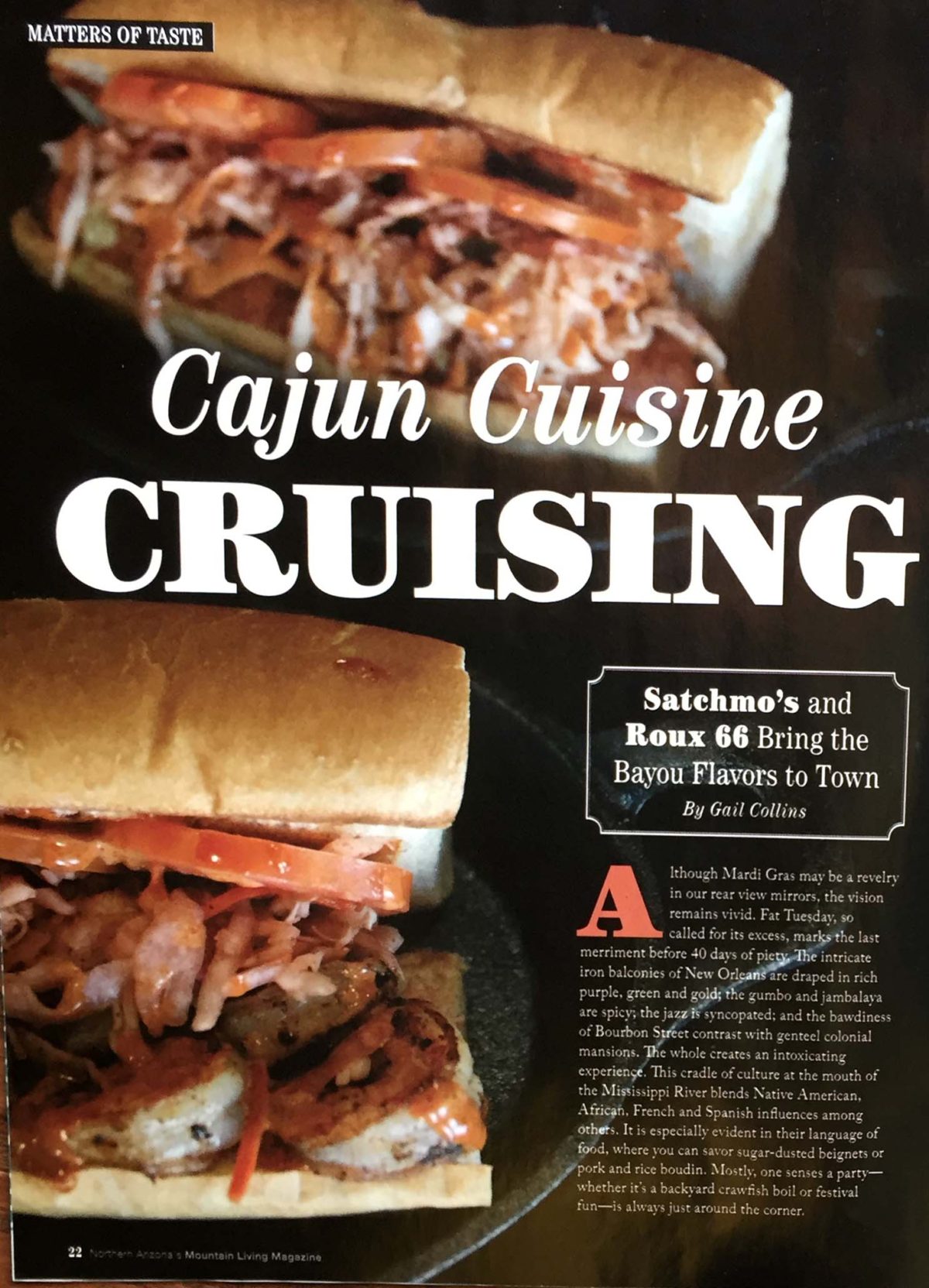Northern AZ’s Mountain Living Magazine, March 2017
Written by Gail Collins
Although Mardi Gras may be a revelry in our rear view mirrors, the vision remains vivid. Fat Tuesday, so called for its excess, marks the last merriment before 40 days of piety. The intricate iron balconies of New Orleans are draped in rich purple, green and gold; the gumbo and jambalaya are spicy; the jazz is syncopated; and the bawdiness of Bourbon Street contrast with genteel colonial mansions. The whole of it creates an intoxicating experience. This cradle of culture at the mouth of the Mississippi River blends Native American, African, French and Spanish influences among others. It is especially evident in their language of food, where you can savor sugar-dusted beignets or pork and rice boudin. Mostly, one senses a party—whether it’s a backyard crawfish boil or festival fun—is always just around the corner.
Our olfactory-driven memories are the strongest, and all of this hit me at the door of Satchmo’s. The spicy smells of Creole cooking took me straight back to our days in New Orleans. And I grinned ear to ear. Owner Jamie Thousand is quick to say a Louisianan might turn up his nose to a batch of Satchmo gumbo offered on their turf. Family recipes are strongly respected and guarded. Thousand honors the Holy Trinity of onion, green pepper and celery in his dishes, but they are also wholly his own.
“We use traditional recipes, but add unique ingredients like au jus from pork butts or brisket, smoked animal lards, and we custom-blend our seasonings,” he said. His methods, too, take simple tasks like sweating off vegetables, in another direction by griddling small batches. This approach gives the jambalaya a caramelized crunch and bronzes the bottom of the cornbread beyond the cast-iron cook pan. “Yeah, some might say I have an inordinately healthy relationship with my grill,” he joked.
Hailing from a large Italian family, cooking was life for Thousand, and he wanted to do it for others. Self-taught and unrelenting, he began with backyard barbecues, and then, pulled a trailer on the competition circuit in Phoenix to hone his smoke skills before opening Satchmo’s in 2009. “Aside from the coals, achieving the perfect smoke ring is affected by weather, humidity and more,” he said. His passion for sticking one’s thumb into a side of ribs to test for tender doneness is taught to an avid kitchen crew. The results enthuse diners, like the couple in the booth next to me, who drive up regularly from Sedona. “We’ve created a culture of going to work with family,” Thousand said. “And the people, who eat here, are guests in the house—we sell experiences.”
The attitude is: Laissez les bon temps rouler or let the good times roll. Satchmo’s dirty rice takes a southwest spin, as do a number of recipes, with twice-smoked chipotle powder. He mixes chunks of beef, pork, and chicken liver to dirty the rice for savory supping. In Louisiana, red beans and rice simmer slowly on laundry day—a longstanding custom. Stew them in pork juices, add andouille sausage and let them hang out on the stove is doing it Satchmo-style. Heat added to creamy beans equals delta bliss. Jalapeño increases the kick of the slightly sweet cornbread.
The food is generally Creole-based, meaning tomatoes are used, as in the jambalaya, which combines cubed ham and andouille to the caramelized Trinity veg. Secret menu items at Satchmo’s are inspired by guests, like laying blackened catfish over the griddled jambalaya. Now, such a secret is a standard.
Po’ boys are handheld heaven. The andouille is split and griddled, of course, and the blackened catfish is a “redfish magic” wannabe—zippy and flaky. Both are served on a six-inch hoagie, slathered with smoked remoulade and piled with vinegar-based coleslaw and tomato.
Stale bread happens, but none is wasted with bread pudding. After baking off the bread and custard, the sliced wedges are fried before drizzling them with hand-squeezed and zested lemon syrup for a fruit-forward bite.
To keep the party going, Thousand expanded his ability to cater for fun and profit with Roux 66. A clever name indeed, as roux is the oil and flour base of many Cajun dishes. Roux 66 expands the number of events possible without losing quality, plus it’s a chance to expand creativity. When someone asks about their ability to handle a particular occasion or food, Thousands says, “We can do it. Our talented crew enjoys the stimulation.” As the namesake for the main eatery, Louis “Satchmo” Armstrong would sing, “What a wonderful world.” NAMLM

